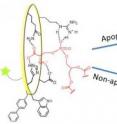Small molecule receptor detects lipid's telltale sign of cell death
Researchers from Boston College have developed a new class of small molecule receptors capable of detecting a lipid molecule that reveals the telltale signs of cellular death, particularly cancer cells targeted by anti-cancer drugs, the team reports in the current electronic edition of the Journal of the American Chemical Society. Researchers led by Assistant Professor of Chemistry Jianmin Gao successfully grafted the key residues of the milk protein lactadherin onto the molecular scaffolding of a short but sturdy circular chain of amino acids to create cyclic lactadherin (cLac) mimics capable of binding to apoptotic, or dying, cells.
Gao said his team spent a year and a half focused on a finding a new method of measuring cell death. The team wanted to create an alternative to traditional tests that measure whether or not a tumor has shrunk in size after several weeks of treatment. The team's focus was on finding a way to measure the presence of dead cells, not the absence of tumor cells.
"We started by looking for a method to detect dying cells," said Gao. "The sensitivity of scientific and medical imaging is better if you look for the appearance of something, rather than the disappearance. What we wanted to look for is that in the initial stages of treatment the therapy's molecules are beginning to trigger the death of cancer cells. That can give you an idea a drug is working much sooner than the current methods of evaluation."
The newly engineered cLac molecules could prove useful as a prognostic tool which could enable oncologists to determine the effectiveness of anti-cancer drugs in a matter of days rather than several weeks, said Gao, who added that further research and testing will need to be conducted.
"Given the small size and ease of synthesis and labeling, cLacs hold great promise for noninvasive imaging of cell death in living animals and, ultimately, in human patients," Gao said.
The cLac molecule is relatively small, built upon on a cyclic peptide scaffold of approximately a dozen amino acids, yet Gao's laboratory tests show it is capable of capturing the lipid molecule phosphatidylserine (PS) -- a function nature accomplishes by using proteins of several hundred amino acids, Gao said. In apoptotic cells PS flows to the surface where cLac is able to latch onto the dying cells while bypassing living cells. In the current report, researchers colored cLac with a fluorescent dye in order to highlight apoptotic cells for fluorescence microscopy. By using appropriate tracing agents, cLac should be detectable through commonly used imaging technology, including MRI and PET.
The cLac molecule could offer a cost-effective, more stable and cleaner alternative to natural PS-binding proteins used for similar purposes, Gao said. Those proteins are bulky and relatively unstable, contain metal cofactors that make results difficult to interpret and show poor ability to penetrate tissue because of their size.
Gao said cLac could also serve as a useful tool for researchers who use protein as a cell death indicator to screen for millions of compounds. The use of the small, peptide-binding molecule could substantially reduce costs for researchers, Gao said.
Recommend this story on Facebook, Twitter,
and Google +1:
Source: Boston College
Other sources
- How effective are anti-cancer drugs? Small molecule receptor detects lipid's telltale sign of cell deathfrom Science DailyTue, 13 Sep 2011, 21:30:28 UTC
- Small molecule receptor detects lipid's telltale sign of cell deathfrom PhysorgTue, 13 Sep 2011, 7:30:23 UTC
